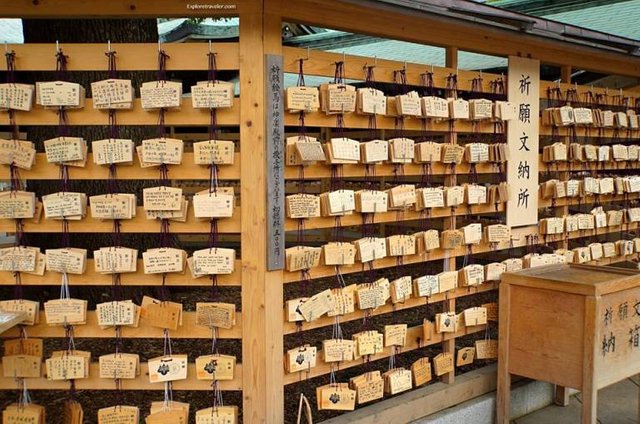Writing an Ema On Wooden Wishing Plaques

Writing An Ema At A Shinto Shrine
Ema, when written in Japanese is made of two Japanese Characters. One character for picture and the other for horse. Horses were seen since ancient times as the “vehicle of the gods.” During the Nara period, 710-784 CE, people would donate horses to the shrines. They felt that the donation would make the gods happy. Happy gods would then answer their wishes. The poor could not give a horse, so the custom began of carving a horse on a piece of wood, clay, or painting on paper. This custom survived and changed through the years.
During the Muromachi period, 1336-1573 AD, some shrines began to display other things beside horses. The Inari shrines, for example, displayed foxes. During the Azuchi-Momoyama period, 1568-1603, there began to be giant halls where artists could come and display their art work. This was something like our modern-day art galleries.
Finally, out of all this, the modern custom of the Ema was born. During the Edo period, small plaques were sold for people to write their wishes on. Whatever your wishes, your hopes, and dreams, you could write them on a wooden plaque and they were placed in the shrines.
Now these plaques are a little larger, and the art work more elaborate. The people come great distances to write their hopes and wishes on an Ema and have it placed in a Shinto Shrine. Since the mingling of Buddhism and Shinto beliefs, on occasion you will see them hanging in some Buddhist temples. This is not a regular practice though.
Currently the Emas are evolving yet again. It is the custom in some shrines to use the pictures of the current zodiac sign. If it is the year of the goat, for example, you will see goat art work on the Ema plaque. Some plaques are even being made in the shape of the current Zodiac sign. Thus you could say that the story of the Ema is still evolving and changing.
ExploreTraveler has been creating travel articles, books, videos, and podcasts for several years now. It is our intention to bring our older material for others here to enjoy here on Steemit, and to create new material here as well. We invite you to click on our links to the original content, and to also follow us there as well.
This post was originally published on Feb. 1, 2016 at:
https://exploretraveler.com/writing-an-ema-on-wooden-wishing-plaques/

If you have come here from our social media channels such as FaceBook or Twitter consider getting your free account, and make sure to follow all of us @exploretraveler @pilgrimtraveler @johngentry @vetvso @johngentryjr @karengentry @elijahgentry @floridagypsy and we will follow you back.
"Helping bring the world together one friend at a time. So travel and discover that the world is full of wonderful people." - ExploreTraveler @exploretraveler
We have a travel tip audio book that will help you that you can purchase at Audible --> Here
Happy Travels,

@2017 ExploreTraveler. All Rights Reserved.
This post has been ranked within the top 10 most undervalued posts in the first half of Feb 04. We estimate that this post is undervalued by $11.53 as compared to a scenario in which every voter had an equal say.
See the full rankings and details in The Daily Tribune: Feb 04 - Part I. You can also read about some of our methodology, data analysis and technical details in our initial post.
If you are the author and would prefer not to receive these comments, simply reply "Stop" to this comment.
A very interesting and informative post. An intriguing insight into Japanese customs.
Thanks